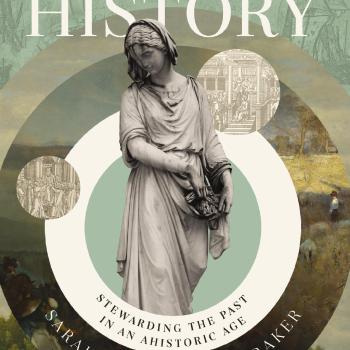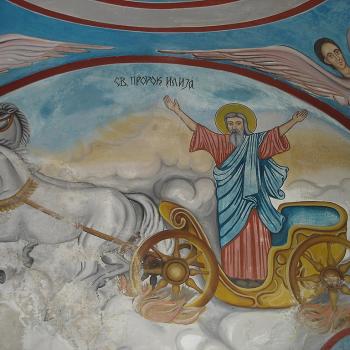Nonetheless, as important as the Torah is, it is not the only scripture Jews read during their services. Selections from the Former or Historical Prophets as well as from the Latter or Literary Prophets are also read. Called a haftarah or "completion," each of these selections are chosen because they resonate with or complement in some way the weekly Torah readings—often by reinforcing, updating, or increasing the significance of one of more of their points in the Torah reading. Isaiah 42:5–43:10, for instance, the haftarah for Genesis 1:1–6:8, draws upon Creation imagery to reassure Israel that God, the all-powerful Maker of All Things, will indeed redeem them from their scattered state and re-create them anew.
Haftarah Structure
The Book of Mormon similarly resonates with and complements the Hebrew Scriptures. However, it does so not haphazardly, a passage here and a passage there, as the Prophets relate to the Torah, but in a very organized, almost systematized way. Working its way backward through the Five Books of Moses and the Prophets, the books of the Book of Mormon connect to these biblical books sequentially, biblical period by biblical period, in reverse order.
1 Nephi, 2 Nephi, Jacob, Enos, Jarom, and Omni, for instance, contain prophetic callings, prophetic poetry, prophetic prayers, prophetic teachings, prophetic warnings, and transcendent prophetic visions as do Isaiah, Jeremiah, Ezekiel, and the other Later Prophets. Words of Mormon and Mosiah document a time when kings ruled over the Nephites, much as 1 and 2 Samuel and 1 and 2 Kings describe a similar era for Israel and for Judah.
In Alma and Helaman, judges contend against external as well as internal foes, just as they do in Joshua and Judges. In 3 and 4 Nephi, a new lawgiver appears, descending from on high, and speaking to the Nephites with power, similar to the way Moses comes down from Sinai and speaks to the Israelites in Exodus, Leviticus, Numbers, and Deuteronomy. And finally, Mormon and Ether work their way back through some of the origin stories of Genesis—the Great Tower, the Flood, the sins of Cain, and even the fall of Adam—as they explore the beginnings of the great evils that beset the Nephites and could, one day, upset the peace of their later readers.
Haftarah Purpose
Reading sections of the Book of Mormon in concert with sections from the Hebrew Scriptures make plain their structural connection. However, the tie between the Book of Mormon and the Hebrew Scriptures is not simply a general or "macro" level linkage; it is also purposeful and functions on a more detailed, "micro" level. Consequently, such an approach also emphasizes the way these two volumes of scripture work together to provide hope for their readers and help them understand and employ the points the Hebrew Scriptures and the Book of Mormon make.
According to Rabbi J.H. Hertz, one of the main aims of haftarah readings is to add to the Torah a "prophetic message of consolation and hope." This the Book of Mormon amply supplies. By connecting to the Hebrew Scriptures chiastically at one of the most cataclysmic events in Jewish history—the destruction of the First Temple and the resulting dispersion of the Jews—the Book of Mormon turns this low point into a turning point and provides hope that the lessons laid out in the Hebrew scriptures can indeed be learned and implemented.
Period of Origins: Genesis
Period of Receiving the Law: Exodus, Leviticus, Number, Deuteronomy.
Period of Judges: Joshua, Judges
Period of Kings: 1&2 Samuel, 1&2 Kings
Period of Prophets: Isaiah, Jeremiah, Ezekiel, Minor Prophets
The Destruction of the First Temple
Period of Prophets: 1&2 Nephi, Jacob, Enos, Jarom, Omni
Period of Kings: Words of Mormon, Mosiah
Period of Judges: Helaman, Alma
Period of Receiving the Law: 3&4 Nephi
Period of Origins: Mormon, Ether
For instance, in 1 Nephi many Jerusalemites ignore Lehi's prophetic warnings just as they did Jeremiah's and are consequently destroyed with their temple. However, Lehi's family and a few of his friends heed his words and are saved from destruction. In this way, following prophets is shown to be not only wise but possible. Similarly in the Book of Mosiah, evil, self-serving tyrants reign much as they do in 2 Kings; however, so do righteous servant-kings. In other words, high position need not always corrupt and power does not always lead to abuse; and as proof, the Book of Mosiah describes one king who was so selfless and so concerned for his people that he renounces monarchy all together, for himself and for his descendants. He then sets up a system of popularly chosen judges specifically to avoid the abuses kings are prone to, and in this way corrects a mistake his ancestors made when they went against prophetic counsel and traded in a similar system for kingly rule (1 Samuel 8:5).




